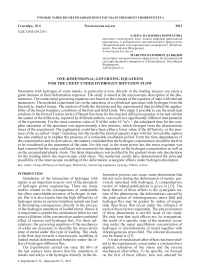One-dimensional governing equations for the creep under hydrogen diffusion flow
Автор: Bormatova E.P., Davydov M.P.
Журнал: Ученые записки Петрозаводского государственного университета @uchzap-petrsu
Рубрика: Технические науки
Статья в выпуске: 6 (135), 2013 года.
Бесплатный доступ
Saturation of some metals with hydrogen, in particular α-iron, immediately in the process of loading can cause a great increase of their deformation response. The study is aimed at the macroscopic description of this phenomenon. The constructed governing equations are based on the concept of the equation of state with internal parameters. The modeled experiment involves saturation of a cylindrical specimen with hydrogen from the electrolyte, loaded torque. The analysis of both research literature and experimental data justified the applicability of the linear boundary conditions of the first and third kinds. This made it possible to use the analytical solutions in the form of Fourier series of Bessel functions for the classical diffusion equation. It turned out that the scatter of diffusivity, reported by different authors, can result in a significantly different interpretation of the experiments. For the most common value of D of the order 10 -9m 2s 4, the calculated time for the complete saturation of the specimen was approximately a few minutes, which diverged from the characteristic times of the experiment. The explanation could have been either a lower value of diffusivity, or the presence of the so-called “traps”. Inclusion of the limited capacity traps with the irreversible capture into the model has also enabled us to explain the presence of a noticeable incubation period. The study did not take into account the dependencies of D on the accumulated plastic strain, the stress gradient, and concentration. From the time dependences of the concentration and its derivatives the authors concluded that the hydrogen concentration should be the first to be considered as a parameter of the state. Furthermore, the creep power index was kept constant but the creep coefficient was assumed to be dependent on hydrogen concentration as well as on the accumulated plastic strain. The latter dependence was justified by the gradual strain rate deceleration for the loading below the macroscopic yield stress. The numerical results have demonstrated the principal possibility of macroscopic modeling of deformation synergistic effects under hydrogen absorption.
Creep, diffusion of hydrogen, diffusivity, governing equations, synergy effects, α-iron
Короткий адрес: https://sciup.org/14750488
IDR: 14750488 | УДК: 539.8:539.219.3
Список литературы One-dimensional governing equations for the creep under hydrogen diffusion flow
- Бекман И. Н. Феноменологическое описание диффузиив дефектных средах//Взаимодействие водородас металлами/Ред. А. П. Захаров. М.: Наука, 1987. C. 143-177.
- Гельд П. В., Рябов Р. А. Водородв металлахи сплавах. М.: Металлургия, 1974. 272 с.
- Работнов Ю. Н. Механика деформируемого твердого тела. М.: Наука, 1988. 712 с.
- Сапунов В. Т. Основы теории пластичностии ползучести: Учеб. пособие. М.: МИФИ, 2008. 220 с.
- Спивак Л. В. Водородв металлах: Учеб. пособие: В 2 ч. Ч. 1. Пермь, 2011. 177 с.
- Спивак Л. В. Водородв металлах: Учеб. пособие: В 2 ч. Ч. 2. Пермь, 2011. 223 с.
- Спивак Л. В., Скрябина Н. Е., Кац М. Я. Водороди механическое последействиев металлахи сплавах. Пермь, 1993. 344 с.
- Addach H., Berjot P., Rezrazi M., Wery M. Hydrogen permeation in iron at different temperatures//Mater. Lett. 2005. Vol. 59 (11). P. 1347-1351.
- Andrew P. L., Haasz A. A. Models for hydrogen permeation in metals//J. Appl. Phys. 1992. Vol. 72 (7). P. 2749-2757.
- Hydrogen in Metals/Ed. by G. Alefeld, J. Volkl. Vol. I. Berlin, Springer-Verlag, 1978. 321 p.
- Namboodhiri Govindan T. K., Nanis L. Concentration dependence of hydrogen diffusion in Armco iron//Acta Mater. 1973. Vol. 21 (5). P. 663-672.
- Oriani R. A. The diffusion and trapping in hydrogen steel//Acta Mater. 1970. Vol. 18 (1). P. 147-157.
- Spivak L. V. Synergy effects in the deformation response of thermodynamically open metal hydrogen systems//Physics Uspekhi. 2008. Vol. 51 (9). P. 863-885.
- Spivak L. V., Skryabina N. E. Intensification of deformation in metal hydrogen systems//Materials Science. 2002. Vol. 38 (4). P. 503-513.
- Tikhonov A. N., Samarskiy A. A. Equations of Mathematical Physics. Dover Publ., 1990. 765 p.
- Xuan Fu-Z., Shao S.-S., Wang Z., Tu S.-T. Coupling effects of chemical stresses and external mechanical stresses on diffusion//J. Phys. D: Appl. 2009. Vol. 42. P. 1-8.
- Zaika Yu. V., Bormatova E. P. Parametric identification ofa hydrogen permeability model by delay times and conjugate equations//Int. J. Hydrogen Energy. 2011. Vol. 36 (1). P. 1295-1305.
- Zhang T.-Y., Zheng Y.-P. Effects of absorption and desorption on hydrogen permeation-I. Theoretical modeling and room temperature verification//Acta Mater. 1998. Vol. 46 (14). P. 5023-5033.
- Zhang T.-Y., Zheng Y.-P., Wu Q.-Y. On the Boundary Conditions of Electrochemical Hydrogen Permeation Through Iron//J. Electrochem. Soc. 1999. Vol. 146 (5). P. 1741-1750.


